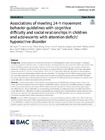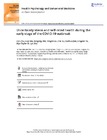Search
Now showing items 1-10 of 21
Meeting 24-h movement behavior guidelines is linked to academic engagement, psychological functioning, and cognitive difficulties in youth with internalizing problems
(Journal of Affective Disorders, 2024-03-15)
Background: This study aimed to investigate associations of meeting 24-hour movement behavior (24-HMB: physical activity [PA], screen time [ST] in the school-aged youth, and sleep) guidelines with indicators of academic ...
Associations of 24-hour movement behaviors with externalizing and internalizing problems among children and adolescents prescribed with eyeglasses/contact lenses
(International Journal of Clinical and Health Psychology, 2024-01-12)
Background: Emerging evidence points towards the psychological benefits of meeting 24-hour movement behavior (24-HMB) guidelines, but such associations have not yet been investigated among children and adolescents of ...
Relationships between features of emerging adulthood, situated decisions toward physical activity, and physical activity among college students: The moderating role of exercise-intensity tolerance
(International Journal of Mental Health Promotion, 2023-12-08)
A significant portion of emerging adults do not achieve recommended levels of physical activity (PA). Previous studies observed associations between features of emerging adulthood and PA levels, while the potential ...
Understanding 24-hour movement guideline adherence and links to school achievement, social-behavioural problems, and emotional functioning among children and adolescents with learning disabilities
(International Journal of Sport and Exercise Psychology, 2023-12-06)
This cross-sectional study examined the associations between adherence to 24-hour movement behaviour (24-HMB) guidelines and indicators of school achievement, social-behavioural problems, and emotional functioning among a ...
24-Hour movement behaviors among visually impaired US children and adolescents
(Mental Health and Physical Activity, 2023-10)
Background
24-h movement behavior (24-HMB) guidelines suggest that children and adolescents should limit screen time (ST), get an adequate amount of sleep (SL), and engage in a sufficient amount of physical activity (PA) ...
A bifactor analysis approach to construct validity and reliability of the affective exercise experience questionnaire among Chinese college students
(International Journal of Mental Health Promotion, 2023-08-10)
Affective exercise experience as an emerging theoretical concept has great potential to provide a more nuanced understanding of individual factors that influence exercise behavior. However, concerning the Affective Exercise ...
Associations of meeting 24-h movement behavior guidelines with cognitive difficulty and social relationships in children and adolescents with attention deficit/hyperactive disorder
(Child and Adolescent Psychiatry and Mental Health, 2023-03-27)
Background
Evidence-based 24-h movement behavior (24-HMB) guidelines have been developed to integrate recommendations for the time spent on physical activity, sedentary behavior, and sleep. For children and adolescents, ...
Validation of sociocultural attitudes towards appearance questionnaire and its associations with body-related outcomes and eating disorders among Chinese adolescents
(Frontiers in Psychiatry, 2023-03-13)
Introduction: The Sociocultural Attitudes Towards Appearance Questionnaire-4 Revised (SATAQ-4R) has been widely used in Western countries to link body appearance that is related to eating disorders and body dissatisfaction ...
Uncertainty stress and self-rated health during the early stage of the COVID-19 outbreak
(Health Psychology and Behavioral Medicine, 2023-02-15)
Objectives
The COVID-19 crisis caused unparalleled uncertainty stress and health-related symptoms among Chinese residents. This study aimed to characterize stress status during the early stage of the pandemic and explore ...
Associations between sedentary behavior and negative emotions in adolescents during home confinement: mediating role of social support and sleep quality
(International Journal of Clinical and Health Psychology, 2023)
Background
Prolonged periods of sedentary behaviour, for instance, engendered by home confinement in Shenzhen city, has led to negative mental health consequences, especially in adolescents. Previous research suggests, ...









